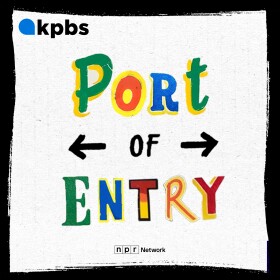Southern San Diego County may get a break from the persistent cross-border sewage flows that have fouled the ocean and endangered public health.
Mexican officials have replaced a 42-inch sewer line in Matadero Canyon that broke in the summer of 2022.
The International Boundary and Water Commission — the federal agency that manages pollution along the U.S. border — is optimistic that the pipeline repair will significantly reduce the amount of tainted water flowing into the United States.
Cross-border flows that bring pollution into the U.S. and foul the South Bay’s Ocean waters, have happened nearly nonstop in 2023.
The repaired pipe will funnel contaminated water away from the border and south of Tijuana.
“We aren’t really excited about it and not doing a lot of hoopla over it because we want to make sure it’s working,” said Maria-Elena Giner, the IBWC commissioner. “Because they actually built a brand-new pipe. And they did it in record time.”
Giner made her comments during a League of Women Voters of San Diego event last week.
The disabled sewer line has been gradually returned to service so engineers can pressure test it and make sure it is functioning properly. They expect to know if the fix worked this week.
It has been an unprecedented year for cross-border sewage flows. Billions of gallons spilled into the Tijuana River Valley and out into the ocean.
The contamination continued during dry weather, when polluted flows typically stop.
South Bay officials have pleaded with state and local officials to declare a state of emergency.
“This is a public health emergency where we’re having impacts to people just breathing in the polluted air,” said Paloma Aguirre, the mayor of Imperial Beach.
The fix will be expensive.
The Environmental Protection Agency’s first estimate to improve sewage systems on both sides of the border was $630 million. Cost estimates for a comprehensive solution have since ballooned.
“What’s it going to take for us to have clean water? That’s the billion-dollar question. Right?” Aguirre said. “Because estimates put this comprehensive solution at anywhere between $900 million, and $1.2 -- $1.5 billion.”
$300 million dollars is available from the United States-Mexico-Canada Agreement signed during the Trump Administration.
Rep. Scott Peters has added $300 million to a supplemental appropriations bill but it is unclear whether that will pass.
Mexico has committed $147 million for improvements on their side of the border, in a negotiated Treaty Minute.
Where officials will get the rest of the money remains unclear.
-
Itamar “Ita” Lilienthal is an emerging biodesigner and architect developing sustainable material alternatives — and he thinks he may have found something big.
-
ICE officers held Viktoriia Bulavina for days inside the basement of a federal building downtown. We hear her story. Plus, food journalists share their suggestions for holiday food and drinks.









